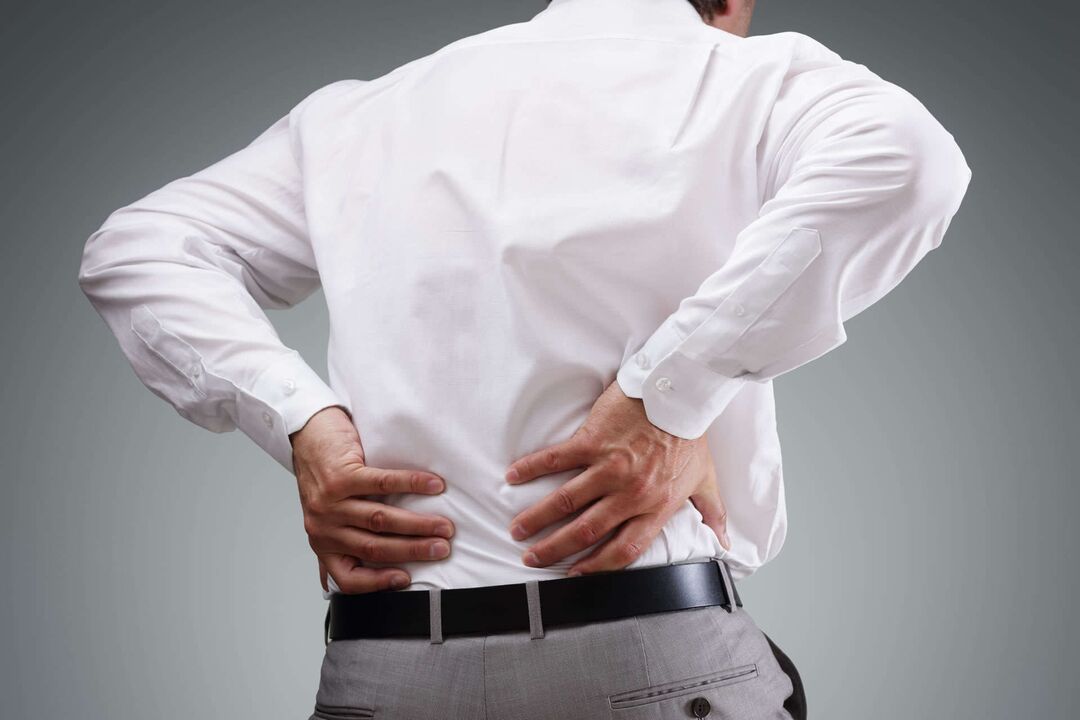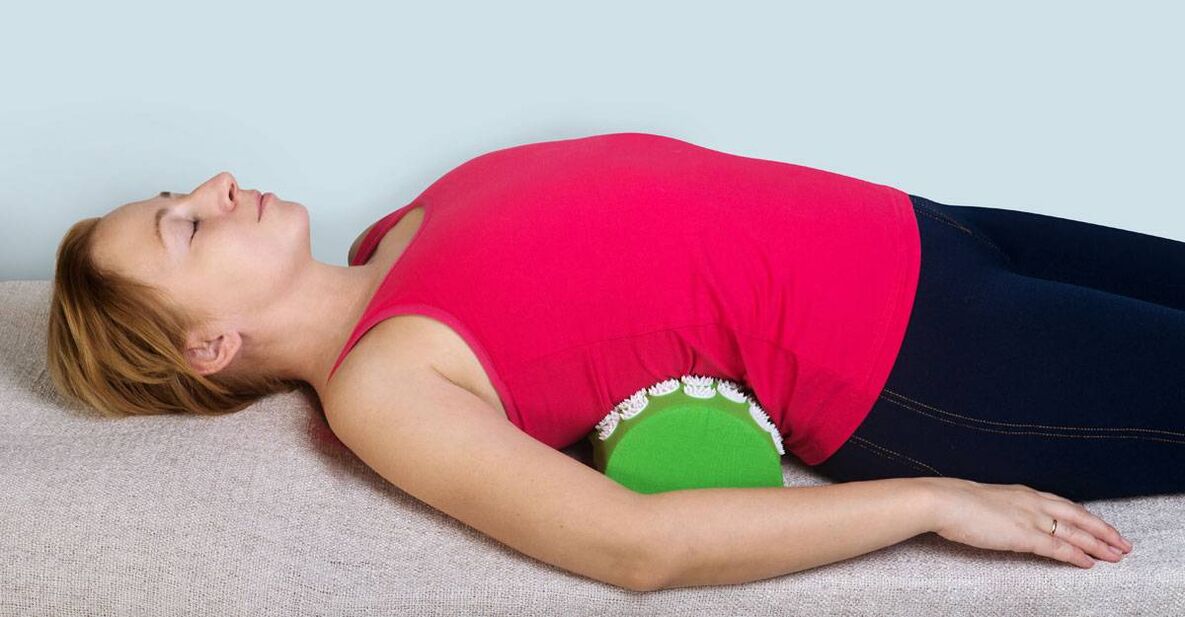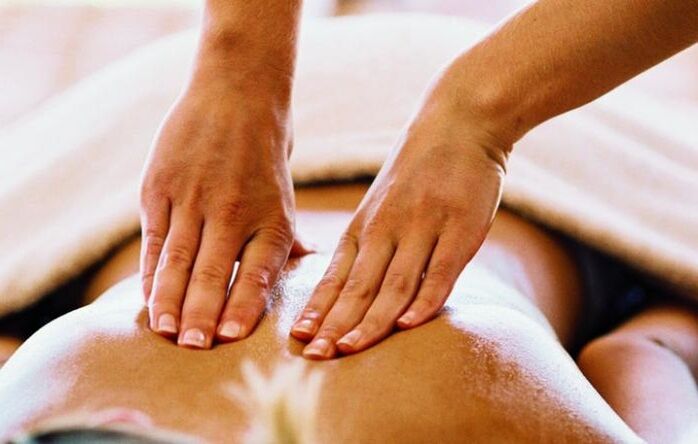Osteochondrosis of the spine is the destruction of bone or cartilage tissue in one or more parts of the spine. The disease is chronic and develops in almost all older people. This is due to the normal aging of the body.

Intervertebral discs are subject to atrophic changes, and the age at which they occur depends on many factors:
- trauma;
- diseases and overload of the spine.
Spinal overload includes:
- walk with a bent back;
- improper seating;
- features of the structure of the spine;
- malnutrition of spinal tissues due to hereditary anomalies.
With osteochondrosis, the nucleus between the vertebral discs loses some of its water. For this reason, metabolic disorders occur in the nucleus and make it difficult for various minerals and vitamins to enter.
After a while, cracks appear on the disk, it becomes flat. Then, nearby joints and ligaments begin to be affected, and tissue inflammation develops. Adjacent vertebrae are displaced due to inflammation. This is dangerous with the appearance of radical symptoms: pain along the affected nerve.
The appearance of an intervertebral hernia is also possible, which in turn can lead to compression of the spinal cord. Osteochondrosis is characterized by the appearance of osteophytes in the vertebral bodies - bone growths. These growths can cause radicular syndrome by squeezing the spinal cord.
The cervical and lumbar regions are often susceptible to osteochondrosis.
Cervical osteochondrosis
Reasons:
- sports activities (weightlifting);
- excess weight;
- metabolic disease;
- sedentary work (programmers, accountants, drivers, etc. );
- straight legs;
- spinal cord injury;
- hypothermia.
Symptoms
The main symptoms of osteochondrosis of the cervical spine are headache and neck pain. A person is worried about severe headaches, neck pain, arm radiation, and sternal pain. The patient may complain of lumbago - the appearance of sharp pain in the neck, muscle spasms and limited movement.
Also, a person may hear a squeak as he turns his neck. Due to constricted nerves and blood vessels, a person may become numb on the tongue and fingertips. The patient will complain of hearing and vision loss, high blood pressure, and weakness in the muscles of the arms and legs.
Thoracic osteochondrosis
This type of osteochondrosis is extremely rare. This is due to the anatomical structure of the thoracic spine. It consists of 12 vertebrae connected to the ribs by joints. The ribs on the front are connected to the sternum. Thus, the spine, sternum and ribs create an excellent framework that protects the internal organs from various injuries.
The vertebrae of the thoracic region have a low height and have long spinous processes located on top of each other like shingles. Due to this structure, this part of the spine has low mobility. The intervertebral discs of the thoracic region are rarely damaged.
Causes of this type of osteochondrosis:
- irrational load distribution;
- delay in feeding intervertebral discs;
- sedentary work;
- presence of scoliosis.
Symptoms
As with other types, pain is a leading symptom of thoracic osteochondrosis.
However, the pain with thoracic osteochondrosis may be different. Dorsalgia - long-term discomfort and mild pain along the thoracic vertebrae. Pain can affect the cervical and lumbar regions.
Dorsago is one of the symptoms of thoracic osteochondrosis, in which the pain occurs in the form of an attack. By its nature, it is intense, sharp, leads to difficulty breathing, and restricts muscle movements. In addition to pain, patients may experience chest tightness, sexual dysfunction, and pain in the heart, kidneys, and stomach.
What is the danger of affecting the thoracic region?
The spine is designed to narrow in the thoracic region, so hernias caused by osteochondrosis will soon cause compression of the spinal cord. This can easily lead to problems in the heart, pancreas, liver and kidneys, as the chest area is connected to all these organs and nerve fibers. Therefore, it is very important to see a doctor in time. It will help you find out where the symptoms of osteochondrosis that are bothering you come from and carry out an authorized treatment of the disease.
Lumbar osteochondrosis
Lumbar osteochondrosis occurs due to weight lifting. Normally, there is a nucleus in the center of the intervertebral disc with a large amount of water. Due to the liquid, the nucleus is slightly compressed and 500 kg of compression is required to break it.
However, the disc affected by osteochondrosis is weakened, and it takes only 200 kg to break it. If a person weighing 70 kg lifts 15 kg in a bent position and this is 200 kg for the spine, the intervertebral disc can be torn. That is why the first signs of spinal osteochondrosis appear when lifting weights.
Symptoms
- pain in the lower back;
- inability to move lower back;
- sleep disorders;
- irritation;
- tiredness;
- inability to meet household needs;
- decreased sexual function in men;
- menstrual disorders;
- cold foot syndrome.
With the spread of osteochondrosis to the sacral region, the patient develops pain and urinary incontinence in the kidney area.
Diagnostics
Osteochondrosis is treated by a neurologist. To begin, he examines the spine, noting the presence of scoliosis. After feeling it, the doctor will be able to understand how the spine, tendons and nerves are affected.
The neurologist will refer the patient for additional examination after suspected osteochondrosis of the spine. This includes X-rays and magnetic resonance imaging. If there is a suspicion of destruction of the intervertebral disc, a discography is performed. It is also prescribed to determine the degree of damage to the nervous system.
In general, osteochondrosis of the spine is very difficult to diagnose. After all, a person may complain of pain in the heart, liver, kidneys, pancreas or sexual dysfunction. However, with a thorough examination, an experienced doctor will be able to suspect the disease and prescribe the right treatment.
Treatment
Treatment of osteochondrosis is a very long and difficult process. In the acute period, the patient needs the rest of the affected segment. If the cervical spine is damaged, the patient should wear a Shantz fixation collar. If the lumbar spine hurts, the patient needs bed rest. It is better to hospitalize the patient. Only then will he be able to fully comply with the established regime. The bed of such a patient should be firm. To do this, a wooden board is placed under the mattress.
Drug treatment
As mentioned above, the main symptom of the disease is pain. Therefore, the patient is prescribed painkillers, painkillers and non-steroidal anti-inflammatory drugs to relieve pain and other symptoms of osteochondrosis.
Unfortunately, long-term use of these drugs causes damage to the mucous membrane of the gastrointestinal tract, and the patient develops the following symptoms:
- nausea;
- Vomiting;
- stomach pain;
- feeling of heaviness in the abdomen.
Gastric or peptic ulcer: It is worse then worthless, it consumes time and resources but returns no sales. Therefore, you should consult your doctor before using this medication. If the pain caused by osteochondrosis lasts for 3 months, antidepressants are prescribed along with these drugs. In addition to their sedative effects, they have been found to be able to reduce pain.
All drugs can be classified as symptomatic therapy. They will help relieve pain, but they will not save a person from the disease itself.
Chondroprotectors are prescribed to repair intervertebral discs and cartilage. These drugs improve the metabolism of connective tissue and help regenerate cartilage. The drugs are taken for a long time, on average - 4 - 6 months.
In addition to restoring tissues and improving their metabolism, these drugs also have an analgesic effect. Another group of drugs necessary for osteochondrosis of the spine are drugs that improve blood circulation, their use helps to dilate blood vessels, and if thioctic acid is taken with it, the metabolism of nerve cells in humans will improve.
As with any disease, patients need calcium supplements. This will restore the function of bone tissue, increase the strength of ligaments and tendons, as well as prevent osteoporosis - a disease associated with osteochondrosis.
Physiotherapy

Dosage load on the spine will improve the patient's condition. But you have to do the exercises very carefully. Physical training is contraindicated in acute periods. Only when the pain subsides can you start exercising a little.
Exercise will improve blood circulation in the spine and strengthen muscles. Thanks to blood flow, metabolism will improve and the repair of damaged intervertebral discs will begin. But you must remember that lessons must be conducted regularly, otherwise there will be no results.
Exercises for cervical spine injury
- Lie on your back and straighten. Place one hand on your abdomen and the other on your chest and inhale, hold your breath for 10 minutes, then inhale and relax. Training time is 3-5 minutes. This should be done 3-5 times a day.
- Lie on your stomach and straighten your legs. You should lift your head and upper chest, leaning on your abdomen and legs. Exercise for 3-5 minutes with a 30-second break.
- Lie on your back and bend your knees. In this case, turn right and left. Exercise for 3-5 minutes with a 30-second break.
Exercises for thoracic lesions
- Lie on your stomach. Put your hands on the floor and lean back. Hold this position for 5-10 seconds. Exercise for 3-5 minutes with a 20-second break.
- Lie on your back. Raise your head and legs ("boat"). Hold for 10-20 seconds. Exercise for 3-5 minutes with a 20-second break.
Exercises for lumbar spine injuries
- Lie on your back, bend your knees and bring them to your chest. Swing back and forth and roll from back to sacrum and back. Slide for up to 2 minutes. Then lie down quietly and rest.
- You need to stand on all fours and bend as much as possible. Exercise for 3-5 minutes with a 20-second break.
- Imagine turning the ring for 2-3 minutes while standing. Exercise 10 times a day.
Surgery
In the absence of the effect of conservative treatment and in the appearance of complications of osteochondrosis, surgical treatment is prescribed. During the stabilization of the spine, the pressure on the spinal cord and roots is eliminated. If a person has an intervertebral hernia, it is removed. This operation is performed only for vital reasons, as it can damage the spinal cord and nerves.
Physiotherapy treatment
Prescribing physiotherapy procedures has a positive effect on the course of the disease and accelerates the recovery process. Allowed with osteochondrosis:

- to visit the sauna or bath;
- swimming in the pool;
- massage;
- paraffin therapy;
- hand therapy;
- laser therapy;
- various baths;
- mud treatment;
- electrophoresis with anti-inflammatory drugs or muscle relaxants;
- magnetotherapy;
- darsonval.
All these procedures improve blood circulation in the diseased area, allow the muscles to relax and the whole body to relax. Physiotherapy procedures are prescribed during rehabilitation, when the patient is not bothered by severe pain.
Prophylaxis
No one is immune to osteochondrosis. After all, we all grow old and our whole body grows old with us. You need to exercise at a young age so that the disease does not disrupt your plans. Moderate physical activity improves blood circulation and normal metabolism. In addition, it trains the muscles that protect the spine. To prevent osteochondrosis, everyone:
- proper nutrition - vitamins and minerals necessary for the body;
- to give up bad habits;
- to engage in physical education;
- do not bend;
- protect your back from hypothermia;
- do not lift very heavy objects;
- take a contrast shower and get nervous;
- avoid stress.
It is especially important for people suffering from this disease to follow all the recommendations, because their failure will lead to aggravation. If you have short-term back pain, you need to seek professional help. Only a doctor can correctly diagnose and prescribe treatment.
Do not delay a visit to the clinic, because it is better to treat the disease at an early stage. Also, do not self-medicate - any medication has its own contraindications, you may not know about it. Strictly follow all the doctor's recommendations, and then the disease will soon return!












































